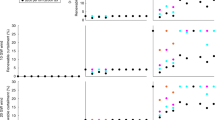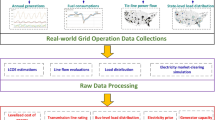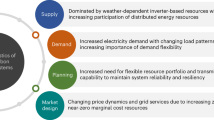Abstract
The penetration of low-carbon technologies in power generation has challenged fossil-fuel-focused electric utilities. While the extant, predominantly qualitative, literature highlights diversification into renewables among possible adaptation strategies, comprehensive quantitative understanding of utilities’ portfolio decarbonization has been missing. This study bridges this gap, systematically quantifying the transitions of over 3,000 utilities worldwide from fossil-fuelled capacity to renewables over the past two decades. It applies a machine-learning-based clustering algorithm to a historical global asset-level dataset, distilling four macro-behaviours and sub-patterns within them. Three-quarters of the utilities did not expand their portfolios. Of the remaining companies, a handful grew coal ahead of other assets, while half favoured gas and the rest prioritized renewables growth. Strikingly, 60% of the renewables-prioritizing utilities had not ceased concurrently expanding their fossil-fuel portfolio, compared to 15% reducing it. These findings point to electricity system inertia and the utility-driven risk of carbon lock-in and asset stranding.
This is a preview of subscription content, access via your institution
Access options
Access Nature and 54 other Nature Portfolio journals
Get Nature+, our best-value online-access subscription
$29.99 / 30 days
cancel any time
Subscribe to this journal
Receive 12 digital issues and online access to articles
$119.00 per year
only $9.92 per issue
Buy this article
- Purchase on Springer Link
- Instant access to full article PDF
Prices may be subject to local taxes which are calculated during checkout




Similar content being viewed by others
Data availability
The data on power-generation assets from the UDI WEPP database were received under licence from S&P Global Market Intelligence and could be obtained under similar arrangements from www.spglobal.com/marketintelligence. The historical data on the countries’ policies were retrieved from the annual REN21 Renewables Global Status Reports publicly available at https://www.ren21.net/reports/global-status-report and from the World Bank’s Carbon Pricing Dashboard publicly available at https://carbonpricingdashboard.worldbank.org. The data that support the graphs within this article and other findings of the study are available from the author upon reasonable request.
Code availability
The study employs a hierarchical clustering algorithm by the free open-source SciPy library in Python. The code is available from the author upon reasonable request.
References
World Energy Outlook 2018: The Future is Electrifying (IEA/OECD, 2018).
Kelsey, N. & Meckling, J. Who wins in renewable energy? Evidence from Europe and the United States. Energy Res. Soc. Sci. 37, 65–73 (2018).
Eberhard, A., Gratwick, K., Morella, E. & Antmann, P. Accelerating investments in power in sub-Saharan Africa. Nat. Energy 2, 17005 (2017).
S&P Global Market Intelligence World Electric Power Plants Database (S&P Global, 2018); www.spglobal.com/marketintelligence
Castaneda, M., Franco, C. J. & Dyner, I. Evaluating the effect of technology transformation on the electricity utility industry. Renew. Sustain. Energy Rev. 80, 341–351 (2017).
Hannon, M. J., Foxon, T. J. & Gale, W. F. The co-evolutionary relationship between energy service companies and the UK energy system: implications for a low-carbon transition. Energy Policy 61, 1031–1045 (2013).
Pollitt, M. G. & Anaya, K. L. Can current electricity markets cope with high shares of renewables? A comparison of approaches in Germany, the UK and the State of New York. Energy J. 37, 69–88 (2016).
Shomali, A. & Pinkse, J. The consequences of smart grids for the business model of electricity firms. J. Clean. Prod. 112, 3830–3841 (2016).
Wainstein, M. E. & Bumpus, A. G. Business models as drivers of the low carbon power system transition: a multi-level perspective. J. Clean. Prod. 126, 572–585 (2016).
Hall, S. & Roelich, K. Business model innovation in electricity supply markets: the role of complex value in the United Kingdom. Energy Policy 92, 286–298 (2016).
Midttun, A. & Piccini, P. B. Facing the climate and digital challenge: European energy industry from boom to crisis and transformation. Energy Policy 108, 330–343 (2017).
Kungl, G. Stewards or sticklers for change? Incumbent energy providers and the politics of the German energy transition. Energy Res. Soc. Sci. 8, 13–23 (2015).
Mitchell, C. Momentum is increasing towards a flexible electricity system based on renewables. Nat. Energy 1, 15030 (2016).
Kungl, G. & Geels, F. W. Sequence and alignment of external pressures in industry destabilisation: understanding the downfall of incumbent utilities in the German energy transition (1998–2015). Environ. Innov. Soc. Transit. 26, 78–100 (2018).
Markard, J. The next phase of the energy transition and its implications for research and policy. Nat. Energy 3, 628–633 (2018).
Parag, Y. & Sovacool, B. K. Electricity market design for the prosumer era. Nat. Energy 1, 16032 (2016).
Richter, M. Utilities’ business models for renewable energy: a review. Renew. Sustain. Energy Rev. 16, 2483–2493 (2012).
Bryant, S. T., Straker, K. & Wrigley, C. The typologies of power: energy utility business models in an increasingly renewable sector. J. Clean. Prod. 195, 1032–1046 (2018).
Richter, M. Business model innovation for sustainable energy: German utilities and renewable energy. Energy Policy 62, 1226–1237 (2013).
Yi, H. & Feiock, R. C. Renewable energy politics: policy typologies, policy tools, and state deployment of renewables. Policy Stud. J. 42, 391–415 (2014).
Löbbe, S. & Jochum, G. in Future of Utilities—Utilities of the Future: How Technological Innovations in Distributed Energy Resources Will Reshape the Electric Power Sector (ed. Sioshansi, F. P.) 323–341 (Elsevier, 2016).
Nillesen, P. & Pollitt, M. in Future of Utilities—Utilities of the Future: How Technological Innovations in Distributed Energy Resources Will Reshape the Electric Power Sector (ed. Sioshansi, F. P.) 283–301 (Elsevier, 2016).
Carley, S., Davies, L. L., Spence, D. B. & Zirogiannis, N. Empirical evaluation of the stringency and design of renewable portfolio standards. Nat. Energy 3, 754–763 (2018).
Delmas, M. A. & Montes-Sancho, M. J. U.S. state policies for renewable energy: context and effectiveness. Energy Policy 39, 2273–2288 (2011).
Yin, H. & Powers, N. Do state renewable portfolio standards promote in-state renewable generation? Energy Policy 38, 1140–1149 (2010).
Ma, C. & He, L. From state monopoly to renewable portfolio: restructuring China’s electric utility. Energy Policy 36, 1697–1711 (2008).
Frei, F., Sinsel, S. R., Hanafy, A. & Hoppmann, J. Leaders or laggards? The evolution of electric utilities’ business portfolios during the energy transition. Energy Policy 120, 655–665 (2018).
Schleicher-Tappeser, R. How renewables will change electricity markets in the next five years. Energy Policy 48, 64–75 (2012).
Annual Report 2018 (Ørsted, 2019).
Carley, S. State renewable energy electricity policies: an empirical evaluation of effectiveness. Energy Policy 37, 3071–3081 (2009).
Polzin, F., Migendt, M., Täube, F. A. & von Flotow, P. Public policy influence on renewable energy investments—a panel data study across OECD countries. Energy Policy 80, 98–111 (2015).
Solangi, K. H., Islam, M. R., Saidur, R., Rahim, N. A. & Fayaz, H. A review on global solar energy policy. Renew. Sustain. Energy Rev. 15, 2149–2163 (2011).
Best, R. & Burke, P. J. Adoption of solar and wind energy: the roles of carbon pricing and aggregate policy support. Energy Policy 118, 404–417 (2018).
Jotzo, F. Australia’s carbon price. Nat. Clim. Change 2, 475–476 (2012).
During the ten-year transition to gas, the power-generation assets of Far Eastern Generating Company have seen a three-fold reduction in their greenhouse gas emissions (in English). PrimaMedia https://primamedia.ru/news/573854/ (2017).
Bringing the Best of the West to Our Customer’s Door (PacifiCorp, 2019).
Climate Change Mitigation: Policies and Progress (OECD, 2015).
Ossenbrink, J., Hoppmann, J. & Hoffmann, V. H. Hybrid ambidexterity: how the environment shapes incumbents’ use of structural and contextual approaches. Organ. Sci. 30, 1319–1348 (2019).
Effective Carbon Rates 2018: Pricing Carbon Emissions Through Taxes and Emissions Trading (OECD, 2018).
Energy Prices and Costs in Europe (European Commission, 2019).
Pfeiffer, A., Millar, R., Hepburn, C. & Beinhocker, E. The ‘2°C capital stock’ for electricity generation: committed cumulative carbon emissions from the electricity generation sector and the transition to a green economy. Appl. Energy 179, 1395–1408 (2016).
Mac Kinnon, M. A., Brouwer, J. & Samuelsen, S. The role of natural gas and its infrastructure in mitigating greenhouse gas emissions, improving regional air quality, and renewable resource integration. Prog. Energy Combust. Sci. 64, 62–92 (2018).
Fei, T. Coal Transition in China. Options to Move from Coal Cap to Managed Decline under an Early Emissions Peaking Scenario (IDDRI and Climate Strategies, 2018).
Coady, D., Parry, I., Le, N.-P. & Shang, B. Global Fossil Fuel Subsidies Remain Large: an Update Based on Country-Level Estimates Working paper no. 19/89 (International Monetary Fund, 2019).
China’s Efforts To Phase Out and Rationalise Its Inefficient Fossil-Fuel Subsidies: a Report on the G20 Peer Review of Inefficient Fossil-Fuel Subsidies that Encourage Wasteful Consumption in China (G20 Peer Review Team, 2016).
Shih, G. China is back to building coal power plants, sparking fears over climate change. Washington Post (20 November 2019).
Coal 2019 (IEA/OECD, 2019).
Seto, K. C. et al. Carbon lock-in: types, causes, and policy implications. Annu. Rev. Environ. Resour. 41, 425–452 (2016).
Apajalahti, E. L., Lovio, R. & Heiskanen, E. From demand side management (DSM) to energy efficiency services: a Finnish case study. Energy Policy 81, 76–85 (2015).
Adams, R. & Jamasb, T. Optimal power generation portfolios with renewables: an application to the UK. Cambridge Working Papers in Economics 1646 (2016).
Gotzens, F., Heinrichs, H., Hörsch, J. & Hofmann, F. Performing energy modelling exercises in a transparent way—the issue of data quality in power plant databases. Energy Strateg. Rev. 23, 1–12 (2019).
Data Base Description and Research Methodology: UDI World Electric Power Plants Data Base (S&P Global, 2015).
Smouse, S. M., Jones, A., Fapohunda, B. O., Render, M. & Hindman, J. W. Coal- and gas-fired power construction and cancellation trends in countries with the most new coal power capacity since 2003. In Proc. ASME 2018 Power & Energy Conference & Exhibition 7466 (ASME, 2018).
Data Base Description and Research Methodology: World Electric Power Plants Data Base (S&P Global, 2018).
Liao, X., Chai, L., Jiang, Y., Ji, J. & Zhao, X. Inter-provincial electricity transmissions’ co-benefit of national water savings in China. J. Clean. Prod. 229, 350–357 (2019).
Reinartz, S. J. & Schmid, T. Production flexibility, product markets, and capital structure decisions. Rev. Financ. Stud. 29, 1501–1548 (2016).
IRENA releases world’s most comprehensive renewable energy capacity figures. IRENA (14 June 2015); https://www.irena.org/newsroom/articles/2015/Jun/IRENA-Releases-Worlds-Most-Comprehensive-Renewable-Energy-Capacity-Figures
Aboumahboub, T., Schaber, K., Wagner, U. & Hamacher, T. On the CO2 emissions of the global electricity supply sector and the influence of renewable power-modeling and optimization. Energy Policy 42, 297–314 (2012).
Peter, J. How does climate change affect electricity system planning and optimal allocation of variable renewable energy? Appl. Energy 252, 113397 (2019).
Mayer, K. & Trück, S. Electricity markets around the world. J. Commod. Mark. 9, 77–100 (2018).
Global Status Reports (REN21, 2005–2019).
Carbon Pricing Dashboard (World Bank, accessed 1 July 2019); https://carbonpricingdashboard.worldbank.org/
Maimon, O. & Rokach, L. Data Mining and Knowledge Discovery Handbook (Springer, 2010); https://doi.org/10.1007/978-0-387-09823-4
Hastie, T., Tibshirani, R. & Friedman, J. H. The Elements of Statistical Learning: Data Mining, Inference, and Prediction (Springer, 2009).
Backman, C. A., Verbeke, A. & Schulz, R. A. The drivers of corporate climate change strategies and public policy: a new resource-based view perspective. Bus. Soc. 56, 545–575 (2017).
Gasbarro, F., Iraldo, F. & Daddi, T. The drivers of multinational enterprises’ climate change strategies: a quantitative study on climate-related risks and opportunities. J. Clean. Prod. 160, 8–26 (2017).
Haney, A. B. Threat interpretation and innovation in the context of climate change: an ethical perspective. J. Bus. Ethics 143, 261–276 (2017).
Weinhofer, G. & Busch, T. Corporate strategies for managing climate risks. Bus. Strateg. Environ. 22, 121–144 (2013).
Kalkuhl, M., Edenhofer, O. & Lessmann, K. Learning or lock-in: optimal technology policies to support mitigation. Resour. Energy Econ. 34, 1–23 (2012).
Conway, D., Dalin, C., Landman, W. A. & Osborn, T. J. Hydropower plans in eastern and southern Africa increase risk of concurrent climate-related electricity supply disruption. Nat. Energy 2, 946–953 (2017).
Bellman, R. Dynamic Programming (Princeton Univ. Press, 1957).
Bellman, R. Adaptive Control Processes: a Guided Tour (Princeton Univ. Press, 1961).
Rousseeuw, P. J. Silhouettes: a graphical aid to the interpretation and validation of cluster analysis. J. Comput. Appl. Math. 20, 53–65 (1987).
Caliński, T., Harabasz, J. & Caliliski, T. A dendrite method for cluster analysis. Commun. Stat. 3, 1–27 (1974).
Davies, D. L. & Bouldin, D. W. A cluster separation measure. IEEE Trans. Pattern Anal. Mach. Intell. PAMI-1, 224–227 (1979).
Halkidi, M. On clustering validation techniques. J. Intell. Inf. Syst. 17, 107–145 (2001).
Efron, B. Computers and the theory of statistics: thinking the unthinkable. SIAM Rev. 21, 460–480 (1979).
Efron, B. & Tibshirani, R. An Introduction to the Bootstrap (Chapman & Hall, 1993).
Buckland, S. T., Davison, A. C. & Hinkley, D. V. Bootstrap Methods and Their Application (Cambridge Univ. Press, 1997); https://doi.org/10.2307/3109789
Acknowledgements
I thank B. Caldecott, A. Haney, C. Hepburn and D. Tulloch for comments on the manuscript. I am also thankful for the financial support to my doctoral research offered by the ESRC Grand Union Doctoral Training Partnership, a Scatcherd European Scholarship by the University of Oxford and the 73 Scholarship Fund for Geography by Hertford College, Oxford, established through the generosity of the college’s alumni—P. Newman and M. Teversham.
Author information
Authors and Affiliations
Corresponding author
Ethics declarations
Competing interests
The author declares no competing interests.
Additional information
Publisher’s note Springer Nature remains neutral with regard to jurisdictional claims in published maps and institutional affiliations.
Supplementary information
Supplementary Information
Supplementary Tables 1–2, Figs. 1–4, Note 1 and refs. 1–6.
Rights and permissions
About this article
Cite this article
Alova, G. A global analysis of the progress and failure of electric utilities to adapt their portfolios of power-generation assets to the energy transition. Nat Energy 5, 920–927 (2020). https://doi.org/10.1038/s41560-020-00686-5
Received:
Accepted:
Published:
Issue Date:
DOI: https://doi.org/10.1038/s41560-020-00686-5
This article is cited by
-
Electric utility plans are consistent with Renewable Portfolio Standards and Clean Energy Standards in most US states
Climatic Change (2024)
-
Global database of cement production assets and upstream suppliers
Scientific Data (2023)
-
Oil majors’ slow transition
Nature Energy (2022)
-
Realigning India’s Vietnam Policy Through Cooperative Sustainable Development: a Geostrategic Counterbalancing to China in Indo-Pacific
East Asia (2022)
-
Process, revived
Nature Energy (2021)



